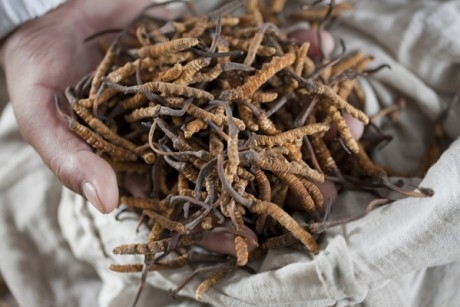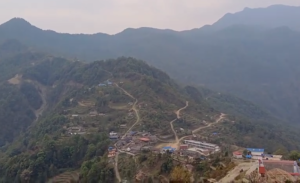The boom in “Himalayan Viagra”

BY CENTER FOR INVESTIGATIVE REPORTING AND JAMIE JAMES———
CHAME, Nepal – In a dim, dusty stockade in this small Himalayan town, Krishna Lama contemplated his ruined life – a dead father, a college career cut short and criminal charges, all because of a potent fungus that promises the vigor of youth and sexual prowess for men.
A devout Buddhist, Lama was a 20-year-old college student home on holiday in 2009, when he was compelled to join a posse protecting the lucrative fields near his home village of Nar, at altitude 13,450 feet and a steep two-day trek from the Annapurna trail in the Manang district.
What ensued was one of Nepal’s most gruesome mass killings – over the fungus called yarsagumba.
Fearing their fields had been poached by interloping yarsagumba pickers from Gorkha, a mob from Nar beat two men to death and threw their bodies into a deep crevasse. They rounded up the five other men and savagely beat them to death with sticks and stones. To conceal their crime, they cut the corpses into small pieces, wrapped them in plastic and threw them into a glacial torrent. The killers, 65 men and boys, swore an oath never to tell anyone what happened, not even their wives.
“Yarsagumba brings a curse,” Lama said. “Our entire village has had to suffer. Even my father had to face that fate.”
Two years before the massacre, Lama’s father had died. He, too, was beaten to death with sticks, though the exact circumstances of his murder remain unclear.
Lama’s story – that he was among the last to arrive on the scene and didn’t witness the killings – is corroborated by police, but as he awaited trial, he had no idea whether the court would accept his version of events or if it would be enough to get him acquitted.
The murders have torn the tiny village apart. Interviews with several of the accused in their stockade in Chame and their families in Nar reveal that they are more fearful of the punishment of their souls in the afterlife than of any judgment meted out by a court of law.
“I am cursed,” Lama said. “I have no hope.”
Lama’s story is just one from a gold rush in the Himalayas. Fortunes are being made – and lives are being ruined – not over gleaming metal nuggets, but in the reckless pursuit of yarsagumba. A rare hybrid of caterpillar and mushroom that grows only in the high alpine meadows of Tibet, Nepal and India, it has been prescribed by traditional healers in Asia for centuries to treat lung and kidney diseases, build up bone marrow and stop hemorrhaging. But it is prized above all for its reputation as a powerful aphrodisiac, earning it the nickname “Himalayan Viagra.”
Yarsagumba – also known by its scientific name, Cordyceps sinesis – was unknown in the Western world until 1994, when two female Chinese athletes at the Asian Games in Hiroshima, Japan, set new world records for mid- and long-distance running.
The astonishing times they posted gave rise to suspicions that they were using illegal performance enhancers such as anabolic steroids, but post-race drug tests revealed no trace of illegal substances. The runners’ controversial coach, Ma Junren, told foreign reporters that the women got their championship edge from daily doses of Cordyceps.
Thus began the yarsagumba boom. It is difficult to find an accurate estimate of the total production of yarsagumba, owing to the high degree of cross-border smuggling to avoid paying taxes and bribes. But according to Daniel Winkler, a botanist specializing in the fungus, it quickly has become the most expensive herbal remedy in traditional Chinese medicine.
Winkler estimates the annual yarsagumba harvest at between 85 and 185 tons, and in some areas, the crop represents the most significant source of income for residents, even greater than mining and industrial production. One official in Tibet’s Dengqen County estimated that 37,000 of the area’s 60,000 inhabitants had participated in fungus collection, Winkler reported in a recent scholarly journal.
“Among the wealthy and powerful in China,” Winkler wrote, “Cordyceps has come to rival French champagne as a status symbol at dinner parties or as a prestigious gift.”
The explosive growth in the yarsagumba market beggars the most extravagant superlatives: In 1992, a pound of the stuff sold for $3; today, the same quantity retails for around $9,400.
Nathan Lee, an apothecary in Hong Kong, said he has customers who spend thousands of dollars a month for daily doses of yarsagumba. “They give their children three to seven pieces a day, to promote good health and help them study,” he said. “They mix it with their breakfast cereal.”
The lucrative trade in the mushroom has transformed the economy of the Himalaya region. An ancient, yak-based culture that survived for centuries in one of the most extreme environments on earth is now unraveling in a tragic collision with the global marketplace.
Tibet is the main source of Cordyceps, but the trade may be having its most profound impact on Nepal, where extreme poverty and decades of political instability have led to deepening social entropy.
Rural economies, which had largely converted to tourism in the early 1990s, languished with the steep decline in foreign arrivals after a Maoist insurgency provoked civil war in 1996. That sent adventurous herb hunters into new terrain in search of the golden mushroom.
Harvesting the exotic fungus
Yarsagumba is the result of a bizarre parasitic relationship between fungus and insect. Spores of the Cordyceps mushroom invade and consume the larvae of the Himalayan bat moth, which live underground at altitudes of 10,000 to 16,000 feet for as long as five years, feeding on roots before they commence their metamorphosis into moths.
After the fungal spores have killed and mummified the larvae, they send up a spindly brown stem, a tiny knob-headed mushroom – and then they are very likely to be picked.
There have been many attempts to farm yarsagumba, but none has ever succeeded. The only way the precious fungus can grow is by the fortuitous concurrence of spore and larva in alpine atmospheric conditions – and brave collectors must be willing to risk their lives to collect it.
On a visit to the Annapurna district of Nepal during the midsummer weeks of the prime harvest season, ancient villages stood nearly deserted as most of the able-bodied population headed up to the picking fields. Schools shut down as students dropped out en masse – with the teachers themselves joining in the rush to find instant wealth.
Some 300 men and women, mostly from the Gorkha and Dhading districts, converged on a spectacularly picturesque place called Ice Lake, surrounded by snow-mantled mountains, more than 13,000 feet above the Annapurna trekking trail. Ice Lake is a relatively new collecting site.
“The collection of yarsagumba around here began eight years ago,” explains Karma Gurung, the 27-year-old manager of a tourist guesthouse in the village of Braga. “Before that, the yaks got it all. A few local people noticed that the yaks up on the mountainside were more active and started collecting it, but it was still small scale. Now, 90 percent of the people collect yarsagumba.”
The pickers, ranging in age from 15 to 40, with the majority males in their teens and early 20s, set up a temporary tent town as the base for their fungal prospecting.
Few of the collectors were well off enough to bring a proper tent; for most of them, sheets of industrial plastic anchored by rocks would serve as their home for the six to eight weeks of the harvest season. They rose at first light in near-freezing temperatures and ate rice, dal and boiled stinging nettles. By 8 a.m., they were climbing the steep incline to the yarsagumba fields.
The collectors spend much of their day on all fours, crawling over the sparsely vegetated plain for a close view. An American visitor spent a good 15 minutes staring intently at a few square feet of turf and saw nothing; then a young man wearing a Chicago Bulls hoodie came to his side and pointed out the tiny stem of a mushroom and carefully excavated it with a spoon.
Once the wrinkly caterpillar carcass was extracted, the man, Padam Bahadur, cleaned away the clinging bits of earth with a toothbrush. The best collectors at Ice Lake might get a dozen to 15 pieces in the course of the day.
At day’s end, having eaten nothing since breakfast except a few dry crackers, the exhausted collectors straggled back to camp. As they neared the settlement, they spotted an itinerant herb dealer coming their way.
A compactly built man in his 30s, Prem Ashok sat on his haunches as the prospectors gathered around him to sell the week’s harvest. Each collector waited in turn as Ashok expertly assayed their haul, wrapped up in paper sacks or instant-noodle packages. Ashok gave them a quick glance, an expert sniff and squeeze.
After rejecting broken or rotten pieces and sorting the ones he wanted to buy according to size and freshness, he paid the collectors from a fat wad of bills in his knapsack.
It was all over quickly. Bahadur was paid 21,000 rupees for a week’s harvest, nearly $300. A hard-working yarsagumba picker can earn as much 200,000 rupees, about $2,500, or more in a season – this in a country where the average annual income by some measures is just $500.
“Some of the collectors use the money to pay for school or give it to their parents to start a little shop,” Bahadur said.Yet he conceded that many young collectors take their money to Katmandu and go on a spree – like gold prospectors everywhere. As the sun set, the collectors were too tired to celebrate their payday. After another meal of rice, dal and nettles, with a pot of boiled potatoes, they relaxed around the fire singing and telling stories until they crept into their makeshift tents to sleep.
Pickers face harsh environment, greed
The camp at Ice Lake shows the yarsagumba boom in Nepal at its most beneficial, a peaceable group of poor people literally scratching a good living from the earth.
Yet it is hard, dangerous work. In 2010, 16 yarsagumba collectors were buried alive by a snowstorm in the Dolpo region while they slept at a camp like the one at Ice Lake.
In May, six yarsagumba pickers died after an avalanche at a high alpine lake called Surma Sarobar, in the Bajhang district. In the same week, a 25-year-old collector fell to his death from a cliff on Mount Churen Himal in western Nepal; the body of a 21-year-old collector who had succumbed to altitude sickness was discovered in the Mugu district. In June, three students in their teens were buried by another avalanche in Dolpo.
Yet the most notorious fatalities in the yarsagumba trade are the result of greed, at the hands of other collectors. In the grisly massacre that ensnared young Krishna Lama, the seven victims were murdered after they were found poaching.
On June 9, 2009, a herder from Nar who was searching for a lost yak spied the intruders from the neighboring Gorkha region, most of them still in their teens, sneaking into yarsagumba fields that were considered as being under the exclusive control of Nar. The herder ran to the village to spread the alarm.
The elders organized a posse to apprehend the poachers – or claim jumpers, in gold rush vernacular. By the communal law that rules rural Annapurna, one man from each of Nar’s 60 households was required to join in the defense of the village’s collective wealth. Because Lama’s father had been murdered two years before, the young man, as head of the household, was compelled to join the posse.
At dawn, a force of the fittest youth stormed the Gorkha camp and attacked the interlopers. The plan had been to capture the intruders, but the violence quickly got out of control.
The men from Nar kept their secret for a month. When relatives of the victims arrived at the Manang district capital of Chame and reported them missing, the police went to Nar and found the decomposing bodies of the two victims in the crevasse.
They arrested most of the adult male population of the village and marched them to Chame. It was the first violent crime to be reported in the district, and Chame did not have a jail; the district education office was converted to a stockade to confine the accused. Many of them were released on parole, but by midsummer of this year, 27 men were still awaiting trial, two years after they were charged.
In June, on the second anniversary of the massacre, the village of Nar postponed the start of the yarsagumba-collecting season to perform a weeklong puja, or purification ceremony.
All the residents who were able to read Tibetan, the language of their religion, convened in a lamasery to chant rituals seeking forgiveness for their collective crimes. A lama danced in a trance for hours, then led a boisterous parade of musicians banging drums and blowing on conchs to dispel evil influences, as the lama blessed the women of the village, who came out to kneel at the crossroads.
Finally, on Nov. 15, sentences were handed down by the court in Chame: The six men who committed the murders were given life imprisonment, and 13 more were convicted as accomplices and sentenced to time served. The rest – including Lama – were acquitted.
The Nar case is now closed, but it reveals the extent to which yarsagumba is entwined with every aspect of life in Nepal – including the nation’s chaotic political situation.
In the 1990s, the Maoist insurgency bankrolled its military operations with the burgeoning yarsagumba trade. And then in July 2009, after the accused murderers were confined in their improvised jail, a delegation from Gorkha descended on Chame, demanding restitution in cash. The Gorkha district is a Maoist stronghold, while the Manang district generally supports the Katmandu government.
They demanded compensation from the Annapurna Conservation Area Project, a quasi-governmental agency that charges foreigners to hike the Annapurna trail. According to Lal Prasad Gurung, director of the agency, the demonstrators grew rowdy and threatened the defendants’ lone lawyer with violence. Eventually, the Maoist-backed Gorkha families won their unprecedented claim for 1 million rupees, nearly $14,000, for each murder victim, which was paid in cash.
The shocking circumstances of the Nar massacre brought international scrutiny. Johan Olhagen, an observer from the United Nations Office of the High Commissioner for Human Rights, supported the defendants’ claim that “they were forced confessions;” while avoiding the word “torture,” he claimed that “the Nepali police were rough with the accused.”
Olhagen said the 36 defendants shared one lawyer, who was denied access to his clients until the case went to trial. The Brooklyn, N.Y.-based International Legal Foundation also sent a representative to Chame.
Since the Nar killings, the police have sent patrols to the collecting fields to avert violent disputes, yet reports of crimes in the highlands continue to emerge.
On June 18, a collector named Satya Raj Bohora was thrown from a cliff on Laki Mountain in the Bajhang district, murdered for his haul of the fungus. It’s impossible to assess accurately the scale of crime committed in rural districts. The Nar murders may have been the first to be reported to the police, but according to Karma Gurung, the guesthouse manager in Braga, “people were killed here before that for poaching yarsagumba, but it was kept secret. It was up to the village to impose justice.”
The perils of the yarsagumba business extend beyond the picking fields to every level of the trade. In July, a gang of bandits held up three herb traders at gunpoint and stole their seasonal take of 5 million rupees, about $70,000, and a large quantity of yarsagumba. Itinerant dealers like Ashok are forced to pay “tax,” a euphemism for a shake-down, to as many as 20 groups, mostly political parties and corrupt local officials in the districts through which the harvested fungus is transported. The trade in Cordyceps is legal, but permits are required at every level of bureaucracy, creating an ancillary gold mine of opportunities for corruption.
The United Communist Party of Nepal, the political arm of the Maoists, is a leading collector of illegal “donations.”
Nepal’s most wanted criminal is Kali Bahadur Kham, a member of the party’s central committee, who was charged with the 2008 torture and murder of a businessman in Koteshwor, a suburb of Katmandu.
In July, police raided Kham’s house in the capital, seizing “a huge cache of arms, cash and illegal yarsagumba,” according to police reports. In a viral video, Kham taunted the police and claimed, “The yarsagumba the police exposed to the media was legal, but they have destroyed the documents (in an attempt) to prove it illegal.” Kham remains at large.
Prem Namdu Lama, a wholesaler of herbal products, said: “Here in Katmandu, it is also dangerous to keep large quantities of yarsagumba at home.” At harvest time, he said, he hires young men with guns to protect him.
As reputation grows, so does demand
The aura of danger that surrounds the yarsagumba trade only adds to its golden glamor. The fabulous prices paid for the mushroom by wealthy consumers are the direct result of the most familiar principle in retail economics: rapidly rising demand and shrinking supply.
Beginning with the publicity arising from the performance of Chinese athletes on a yarsagumba regimen and continuing with international news reports about the Nar murders, the awareness of Cordyceps – and particularly its status as an aphrodisiac to boost male sexual performance – has raised the demand exponentially.
In the West, dietary supplements containing trace amounts of inferior-grade Cordyceps and Cordyceps extract have capitalized on the growing notoriety of yarsagumba. But these supplements do not have anything approaching the potency of the premium-grade fungus purveyed by traditional Chinese apothecaries. There are no restrictions on the importation of yarsagumba to the United States, as it has no psychoactive properties and no significant side effects.
The fungus’s reputation is powered by the anecdotal reports of consumers as much as by ancient tradition: In other words, it appears to work. And medical research has backed up claims for its efficacy. A study at Stanford University’s medical school found an increase of 17-ketosteroids in the urine of men taking daily doses of yarsagumba, which indicates an increased production of androgen and other sex hormones in the adrenal gland and testicles.
Controlled animal tests offer credible evidence that regular yarsagumba use decreases recovery time between orgasms and increases the volume of semen production. In another blind trial on human subjects, 65 percent of Cordyceps eaters reported an enhanced sex drive.
Yet despite local prospectors’ informal exploration of the Himalayas for new collecting fields, the available supply is steadily shrinking. Prem Namdu Lama estimated that the total harvest had declined 20 percent over the previous year. Some conservationists claim this is the result of overharvesting, though neither Cordyceps sinesis nor the moth host of yarsagumba appears to be in any danger of extinction.
Prem Namdu Lama believes that the contracting supply is the result of changes in the weather. “The reason for the decline is there was no snow, no rain,” he said. “If the snow falls, the yarsagumba will come back.”














